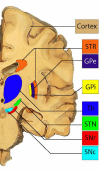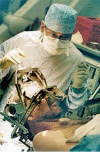Surgical insights into Parkinson's disease
- PMID: 16672757
- PMCID: PMC1457758
- DOI: 10.1177/014107680609900515
Surgical insights into Parkinson's disease
Abstract
Surgery for Parkinson's disease was popularized in the mid-twentieth century before the advent of effective medical therapies. Early lesioning treatments contributed to our understanding of the functional anatomy of Parkinson's disease. Observations of the limitations and long-term complications of established pharmacological therapies for Parkinson's disease, together with major contributions from animal research to elucidate the roles of the basal ganglia in movement disorders, inspired a recent renaissance in neurosurgical interventions for Parkinson's disease including deep brain stimulation; this continues to yield much neurophysiological information. The development of potentially restorative treatment modalities, such as gene therapy, neural transplantation and nanotechnology, hold much promise for surgery, both therapeutically and in revealing further insights into Parkinson's disease pathophysiology.
Figures



References
Publication types
MeSH terms
Grants and funding
LinkOut - more resources
Full Text Sources
Medical

